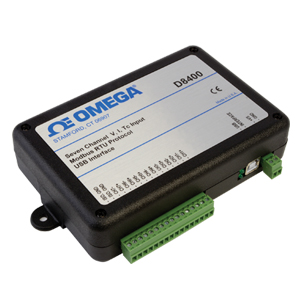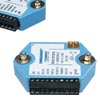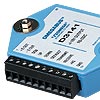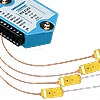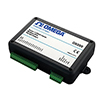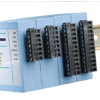D8000_Series
Omega USB signal capture and generation.
€618,35
D8400
-
The D8000 series are not CE compliant. Please see the USB, RS232, RS485 and Ethernet Data Acquisition Systems category for possible alternatives or contact our sales dept.
-
Complete Data Acquisition Systems
-
Analogue and Digital I/O Models Available
-
USB Interface
-
Modbus® RTU Protocol
-
Up to 25 Conversions per Second
-
500 Vrms Analog Input or Analogue Output Isolation
-
16-Bit Analogue Input Measurement Resolution
-
Continuous Self-Calibration; No Adjustments Required
-
Programmable Digital Filters for Analogue Inputs
-
Requires 10 to 30 Vdc Unregulated Supply
-
Removable Screw Terminal Plug Connectors Supplied
-
APPLICATIONS
-
Process Monitoring and Control
-
Data Logging to any Host Computer
-
Product Testing
USB , RS232 , RS485 e Ethernet Sistemi di Acquisizione Dati - Visualizza i prodotti correlati
Descrizione
The D8000 series are not CE compliant. Please see the USB, RS232, RS485 and Ethernet Data Acquisition Systems category for possible alternatives or contact our sales dept.
The D8000 series USB interface modules are a family
of complete data acquisition modules for use in process
control systems. The analogue input models can measure
process signals such as thermocouples, 4 to 20 mA
current loops, and discrete contact closures. The analogue
output models can generate voltage or current signals
for controlling annunciators or valves. The digital input
and output models can sense the state of remote digital
signals or control solid state relays. Complete data
acquisition systems can be created with ease with the
D8000 modules and a host computer.
The modules provide direct connection to a wide variety
of sensors and annunciators such as thermocouple
probes, 4 to 20 mA loops, and DC voltage. They
perform all signal conditioning, linearization and contain
no internal pots or DIP switches. All user-selectable
features such as ranges, communications settings are
stored in nonvolatile EEPROM, which maintains these
values even after power is removed.
The D8000 series USB interface modules connect to
a host computer using a USB interface cable and they
communicate using a virtual serial communications port
using the Modbus RTU protocol.
Use a USB cable to connect the D8000 to a host
computer. Plugging the cable into the computer will
create a virtual serial port in the computer. The virtual
serial port will be used by the host to communicate with
the module. Serial communication ports are supported
by almost all data acquisition and process control
programs in the marketplace.
The Modbus RTU protocol is used to read and write
data values to the D8000 series modules. The Modbus
RTU protocol is a serial protocol and communicates
with external devices through serial ports. The Modbus
RTU protocol is widely recognized throughout the data
acquisition industry and is supported by almost all
commercial process control programs.
Multiple D8000 series modules can be connected to
one host computer. A unique and separate serial port
is created for each module that is connected. The
serial port approach provides instant compatibility with
almost all industry standard data acquisition programs
that support the Modbus RTU protocol.
With the D8000 series modules, anyone familiar with
a personal computer can construct a data acquisition
system. This approach to data acquisition is very
flexible, easy to use and cost effective. The modules
can be mixed and matched to fit your application. You
do not need engineering experience in complicated
data acquisition hardware to build a system.
ANALOGUE INPUT MODULES
The D8100 through D8400 series analogue input
modules contain seven differential analogue input
channels. Each module contains analogue signal
conditioning circuits that are optimized for a specific
signal input type. Signal types include DC voltage,
4 to 20 mA current loops, and eight thermocouple
types. Each input channel can be programmed to
accept a different signal input range.
The sensor signals are converted to digital data
with a microprocessor-controlled integrating A/D
converter. Offset and gain errors in the analogue circuitry
are continuously monitored and corrected using
microprocessor techniques.
The analogue input modules communicate the resultant
data values as 16-bit unsigned integer numbers
that represent a percentage of the full. The modules
continuously convert data values at the rate of up to
25 conversions per second and store the latest result
in a buffer. The data values are requested by sending
a Modbus query to the module. The D8000 series
modules will instantly respond by communicating the
data values back to the host processor.
ANALOGUE OUTPUT MODULES
The D8500 analogue output modules contain two
12-bit digital to analogue converters (DAC) for generating
either voltage or current output signals. The output
signal type for each DAC is user-selectable and each
DAC is independently controlled via a host computer
using the Modbus RTU protocol. Four different analogue
output ranges are available, two voltage ranges and two
current ranges.
The D8500 analogue output modules contain userselectable
features such as programmable output
slew rate, a communications watchdog timer and
programmable startup signal value. They also include
an 8-bit analogue to digital converter for analogue readback
the output signal.
The communications watchdog timer can be used
to move the analogue output signal to a known “safe”
condition in the event of a communications failure.
DIGITAL INPUT MODULES
The D8710 digital input modules contain 15 individual
inputs for monitoring logic levels, contact closures, or
other ON/OFF signals in a data acquisition system.
Each digital input terminal contains a pull-up biasing
resistor allowing for direct connection to a set of
contacts. The input terminals can accept signals
between ±30 Vdc without damage.
DIGITAL OUTPUT MODULES
The D8720 digital output modules contain 15 individual
open-collector transistor outputs for controlling
annunciators, lamps, or other devices that require an
ON/OFF signal.
The D8720 digital output modules also contain
programmable features such as a communications
watchdog timer and programmable startup signal
values for each bit.
The communications watchdog timer can be used
to move the digital output signals to a known “safe”
condition in the event of a communications failure.
COMMUNICATIONS
The D8000 series modules are designed to easily
interface with computers using a USB interface. The
USB interface creates a virtual serial communications
port on the host computer. All communications to and
from the module, through the virtual serial port are
performed using the Modbus RTU protocol. A new
serial port is added for each D8000 series module.
MODBUS COMMAND SET
The D8000 series modules use the Modbus RTU
protocol for communications. The Modbus RTU binary
protocol uses a master-slave technique, in which only
the master device can initiate transactions. The slave
devices respond by supplying the requested data to
the master or by performing the requested action in
the query. The master can address any slave device.
The returned messages are considered response
messages. The supported master function codes are:
Modbus RTU Functions and Descriptions
01 – Read Coil Status
02 – Read Register Status
03 – Read Holding Registers
04 – Read Input Register (Analogue Inputs)
05 – Force Single Coil
06 – Preset Single Register
0F – Force Multiple Coils
10 – Preset Multiple Registers
PROCESS CONTROL SOFTWARE
Modbus RTU protocol is one of the most widely
supported serial protocols in the data acquisition
market. Modbus RTU software drivers are available
for almost every data acquisition software program
available today. Thus providing instant connectivity
between the D8000 modules and most data
acquisition software programs.
SETUP
The D8000 series modules are initialized at the
factory using the Modbus RTU protocol. User
selectable features such as individual channel range
selection and digital filters are easily configured
using the D6000/D8000 series utility software. Each
D8000 module must be properly configured before
installation into a Modbus system.
UTILITY SOFTWARE
Complimentary Utility Software is included with each
module. The software is compatible with Windows
operating systems and distributed on CDROM.
The Utility Software simplifies configuration of all
user selectable options such as device address,
baud rate and filtering constants. The latest version
of our software is always available on our web site.
SPECIFICATIONS(Typical at +25°C and nominal power supply unless
otherwise noted)
GENERAL
Programmable Digital Filters: In analogue input modules
Max CMV (Input to Output at 115 Vrms, 60 Hz): 500 Vrms
Setups: Stored in EEPROM
Unused Analogue Input Channels: Software disable
INTERFACE
Communications: Modbus RTU protocol
Interface: USB port
POWER REQUIREMENTS
Supply Voltage: Unregulated 10 to 30 Vdc; protected
against power supply reversals
ENVIRONMENTAL
Operating Temperature Range: -25 to 70°C
Storage Temperature Range: -25 to 85°C
Relative Humidity: 0 to 95% RH non-condensing
PACKAGE, DIMENSIONS AND CONNECTORS
Case: ABS thermoplastic, UL-94-5VA rated
Dimensions: 102 H x 152 W x 36 mm D
Mounting Holes: 165 mm on centre
Connectors: Screw terminal barrier plug (supplied)
MODULE SPECIFICATIONS
D8100 VOLTAGE INPUTS
Number of Channels: 7 differential voltage inputs
Ranges: ±0.025V, ±0.05V, ±0.1V, ±1V, ±5V, ±10V
Resolution: 16-bit ADC, 25/20 conversions per second
Accuracy: ±0.05% of FS max
Span Tempco: ±50 ppm/°C max
Input Burnout Protection: To 250 Vac
Input Impedance: 20 MΩ min
Power Requirements: Serial = 1.4 W
D8200 CURRENT INPUTS
Number of Channels: 7 differential current inputs
Range: ±20 mA
Resolution: 16-bit ADC, 25/20 conversions per second
Accuracy: ±0.05% of FS max
Span Tempco: ±50 ppm/°C max
Voltage Drop: 2.0V max
Input Impedance: <100 Ω (70 typical)
Power Requirements: Serial = 1.4 W
D8300 THERMOCOUPLE INPUTS
Number of Channels: 7 differential thermocouple
inputs
Thermocouple Types: J, K, T, E, R, S, B, and C
Ranges:
J: -200 to 760°C (-328 to 400°F)
K: -150 to 1250°C (-238 to 2282°F)
T: -200 to 400°C (-328 to 752°F)
E: -100 to 1000°C (-148 to 1832°F)
R: 0 to 1750°C (32 to 3182°F)
S: 0 to 1750°C (32 to 3182°F)
B: 0 to 1820°C (33 to 3308°F)
C: 0 to 2315°C (32 to 4199°F)
Thermocouple Accuracy
(Error From all Sources) from 0 to 40°C Ambient:
J, K, T, E: ±1.5°C max
R, S, B, C: ±3.5°C max (300°C to +F.S.)
Resolution: 16-bit ADC, 25/20 conversions per second
Input Impedance: 20 MΩ min
Cold Junction Compensation: Automatic
Lead Resistance Effect: <40 µV per 350 Ω
Indication: Open thermocouple and over range
indication
Input Burnout Protection: To 250 Vac
Power Requirements: Serial = 1.4W
D8400 VOLTAGE, THERMOCOUPLE, CURRENT INPUTS
Number of Channels: 7 differential voltage,
thermocouple, current inputs
Specifications: Equal to D8100, D8200 and D8300
series
D8500 ANALOGUE OUTPUTS
Number of Channels: Two analogue outputs
(programmable for voltage or current output)
Voltage Ranges: 0 to 10 Vdc, ±10 Vdc
Current Ranges: 0 to 20 mA, 4 to 20 mA
Update Rate: 250 conversions per second
Accuracy: ±0.1%
Resolution: 12-bit DAC resolution
Span Tempco: ±25 ppm/°C max
Settling Time to 0.1% FS: 1 mS
Communications: Watchdog timer
Current Output Compliance: ±12 Vdc
Voltage Output Drive: 5 mA max
Analogue Output Signal Readback: 8-bit ADC
Isolation: 500 Vac, output common to system ground
Current Output Burnout: Protected to 250 Vac
Power Requirements: Serial = 2.1 W
D8710 DIGITAL INPUTS
Number of Channels: 15 digital inputs
Internal: 10K pull-up resistors on each bit;
accept direct switch closure
Logic “0”: <1 Vdc
Logic “1”: >3.5 Vdc
Input Burnout: To ±30 Vdc without damage
Isolation: 500 Vac, input common to system ground
Power Requirements: Serial = 0.75 W
D8720 DIGITAL OUTPUTS
Number of Channels: 15 open-collector outputs to
30 Vdc, 100 mA max
Vsat: +0.3 Vdc max at 100 mA
Short Circuit Protection: To 500 mA
Communications: Watchdog timer
Digital Output Update Rate: 4.5 Hz
Isolation: 500 Vac, output common to system ground
Power Requirements: Serial = 1.0W
† Tutti gli importi indicati in EUR
Nota: Comes complete with operator’s manual and utility software on CD and 90 cm long USB interface cable.
Esempio di Ordinazione: (1) D8300 7-channel differential thermocouple input module, €576,16
 Vicino
Vicino

